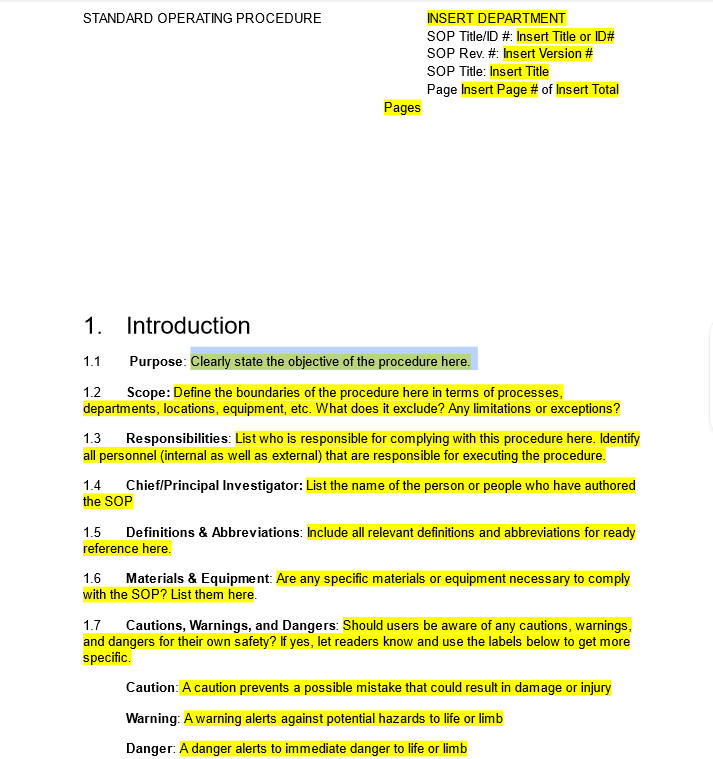Are your business operations hitting the mark every time, or do you find your team's efforts occasionally misaligned with your company's goals?
The key to finding consistent success might just lie in having effective standard operating procedures (SOPs). Think of SOPs as more than just a document and instead as a tool to help build your company's playbook. SOPs are pivotal in quickly bringing your team members up to speed on new procedures, ensuring that every action taken is in sync with your business goals.
With a set of well-defined SOPs, your team can confidently tackle their tasks in a consistent and accurate manner, knowing they have a solid reference point to guide them. This results in streamlined operations, enhanced productivity, and a higher maintenance of quality standards.
In this article we're going to cover:
- What a Standard Operating Procedure Is
- The Benefits of Having SOPs
- Challenges in Implementing SOPs
- Steps to Create Effective Standard Operating Procedures
What is a Standard Operating Procedure?

A standard operating procedure is a set of written instructions that detail the step-by-step process to perform a specific task or activity in a consistent and efficient manner. It serves as a guide to ensure that operations are carried out with uniformity, quality, and safety, reducing variability and enhancing predictability in outcomes.
What's the Difference Between an SOP and a Process
The terms 'SOP' and 'process' are often used interchangeably, but they have distinct meanings. A process is a broader concept that refers to a series of actions or steps taken to achieve a particular end. It is a high-level description of a task or series of tasks within an organization.
On the other hand, an SOP is a detailed, written document that specifically describes how to execute a process. It provides a detailed, step-by-step breakdown of the procedures necessary to carry out a particular task or function. SOPs are more prescriptive and detailed than a general process description, offering clear instructions that leave little room for variation.
In summary, while an internal process outlines what needs to be done within an organization, an SOP details how it should be done. SOPs are essentially the practical application of a process, ensuring consistency and compliance in the execution of that process.
Maximizing Business Potential: The Benefits of Creating and Using SOPs
Standard operating procedures should be viewed as more than just a set of instructions; they're a game-changer for any business.
In the following section, we're going to show you exactly why SOPs are crucial. They're not just about doing things the right way; they're about boosting efficiency, keeping your team aligned, and driving your business forward. From ensuring quality to keeping valuable knowledge in-house, the advantages of well-implemented SOPs are numerous and impactful.
Read on to find just a few ways that creating and maintaining an SOP can make a real difference in your day-to-day operations and long-term success.
- Ensuring Quality and Consistency: SOPs are crucial for maintaining high standards in tasks and processes, serving as a comprehensive guide to achieve desired quality in products and services.
- Knowledge Retention and Continuity: They play a vital role in preserving vital business knowledge, ensuring that critical information and expertise remain within the company even as personnel changes.
- Preventing Process Drift: SOPs help in maintaining the integrity of processes over time, preventing the gradual deviation from established procedures that can lead to inefficiencies and errors.
- Streamlining Employee Training: They are invaluable for training new staff members, providing clear and concise guidelines that facilitate quicker and more effective learning and integration into the team.
- Reducing Rework and Delays: By clearly defining standards and procedures, SOPs help minimize the need for rework and the delays it causes, contributing to a smoother, more efficient operational flow.
- Meeting Customer Requirements: SOPs ensure that specific customer requirements are consistently met, safeguarding business relationships and reputational integrity.
- Facilitating Continuous Improvement: They are instrumental in embedding improvements and innovations within the business, ensuring that changes are standardized and sustained over time.
- Supporting New Process Integration: SOPs are essential when introducing new tools or equipment, providing necessary guidance on optimal usage and maintenance for maximizing the benefits.
Why Businesses Struggle with Implementing SOPs
While standard operating procedures are vital for business efficiency and quality control, their effective implementation often presents significant challenges. Let's take a look at some of the common obstacles businesses face with SOPs, shedding light on why they sometimes fail to deliver their intended benefits.
From the dusty corners of forgotten manuals to the gaps between theory and practice, understanding these hurdles is key to unlocking the full potential of SOPs. This section dives into the reasons behind the struggles, offering insights into how businesses can overcome these barriers to make SOPs an integral and effective part of their operations.
- Perception and Engagement Issues: SOPs are often met with skepticism or disinterest, seen as bureaucratic rather than helpful. This attitude can lead to underutilization or neglect of these vital documents.
- Authorship Disconnect: Frequently, SOPs are written by individuals removed from the actual process, leading to a gap between the written instructions and practical execution. Ensuring the right people contribute to SOP creation is crucial.
- Neglect and Obsolescence: Once written, SOPs can be forgotten, becoming outdated as practices evolve. Keeping SOPs relevant and updated is essential for them to remain useful.
- Lack of Integration in Daily Work: Often SOPs are not seamlessly integrated into daily operations, existing as separate entities rather than essential tools. Making SOPs a central part of everyday work is necessary for their effectiveness.
- Inadequate Management and Revision Control: Managing and updating SOPs is frequently overlooked. Establishing a process for regular review and updating, with a dedicated person responsible for oversight, can ensure SOPs stay current and effective.
How to Write Effective Standard Operating Procedures
Crafting an effective standard operating procedure is a crucial step towards operational excellence in any organization. It's not just about documenting processes; it's about creating clear, concise, and actionable guides that ensure consistency and quality in every task.
This section delves into the art and science of writing SOPs that are not only compliant and comprehensive but also user-friendly and practical. Whether you're drafting your first SOP or looking to refine existing ones, these steps will guide you in creating procedures that enhance efficiency, reduce errors, and foster a culture of continuous improvement within your team.
Step 1: Identify the Purpose and Scope
Begin by clearly defining the purpose of the SOP. What process or task does it cover? Who is it intended for? Establishing the scope helps ensure that the SOP is focused and relevant, avoiding unnecessary details that could lead to confusion.
Step 2: Involve the Right People
Involve individuals who are directly engaged with the process in SOP creation. Their hands-on experience ensures that the SOP accurately reflects the practical aspects of the task, including nuances and best practices that may not be obvious to those not regularly performing the task.
Step 3: Choose a Clear Format
Select a format that is easy to follow. This might include numbered steps, bullet points, flowcharts, or a combination of these. A consistent format across all SOPs in your organization aids in readability and comprehension.
Step 4: Write Concise, Action-Oriented Steps
Each step in the SOP should be clear and concise, using action-oriented language. Avoid jargon and technical terms that may not be understood by all users. Each step should be direct and to the point, leaving no room for interpretation.
Step 5: Include Necessary Details
While being concise, ensure that all necessary details are included. This can include specific settings for machinery, safety precautions, quality control checkpoints, and any other critical information required for the task.
Step 6: Review and Test the SOP
Once drafted, review the SOP with the team. Test it in the actual work environment to ensure it is practical and effective. Feedback from those who will use the SOP is invaluable for identifying any areas that need clarification or adjustment.
Step 7: Implement Training and Communication
Properly train your team on the new SOP. Clear communication about the SOP's purpose, the importance of adherence, and any changes from previous procedures is crucial for effective implementation.
Step 8: Regularly Review and Update
SOPs are living documents that should evolve with your business processes. Schedule regular reviews to update the SOPs as necessary, ensuring they remain relevant and effective over time.
By following these steps, you can create SOPs that are not only effective in guiding your team but also instrumental in enhancing the overall productivity and quality of your work.
Embracing SOPs: The Pathway to Business Excellence
As we've explored, SOPs are far more than mere documents; they are the strategic blueprints that guide teams towards excellence, ensuring quality, consistency, and efficiency in every operation. Essentially, they serve as linchpins that hold together the diverse elements of an organization, enabling it to function as a cohesive, efficient unit.
The journey of implementing and maintaining effective SOPs might be challenging, but it is undeniably rewarding. Businesses that successfully navigate these challenges improve their ability to foster a culture of clarity, accountability, and continuous improvement, crucial ingredients for long-term success and resilience in a competitive marketplace.
From enhancing employee training to streamlining processes, from retaining crucial knowledge to adapting to evolving customer needs, SOPs are indispensable tools for businesses aiming to thrive in an ever-changing environment. They are not just necessities but powerful catalysts for growth, innovation, and leadership in any industry.
As we conclude, remember that the creation and refinement of SOPs is an ongoing process, a commitment to operational excellence that evolves with your business. By embracing SOPs, you're not just adopting a set of procedures; you're embarking on a journey towards a more organized, efficient, and successful future.
Let your SOPs be your guide to this journey, turning challenges into stepping stones for success, and aspirations into tangible achievements. In the world of business, those who master the art of SOPs don't just survive; they lead, innovate, and set new benchmarks for excellence.


.jpg)